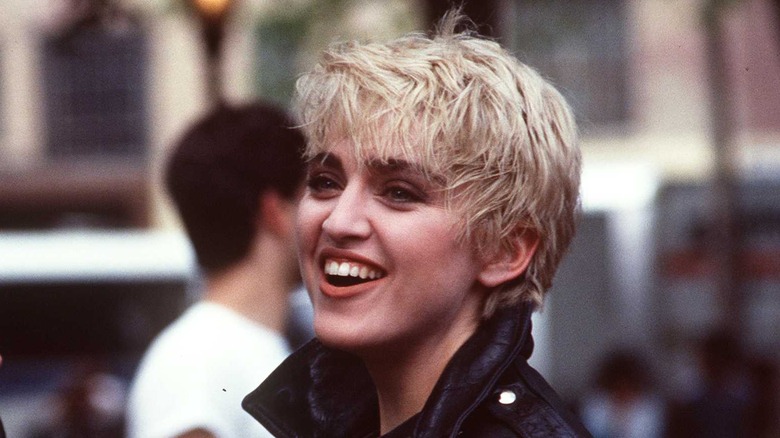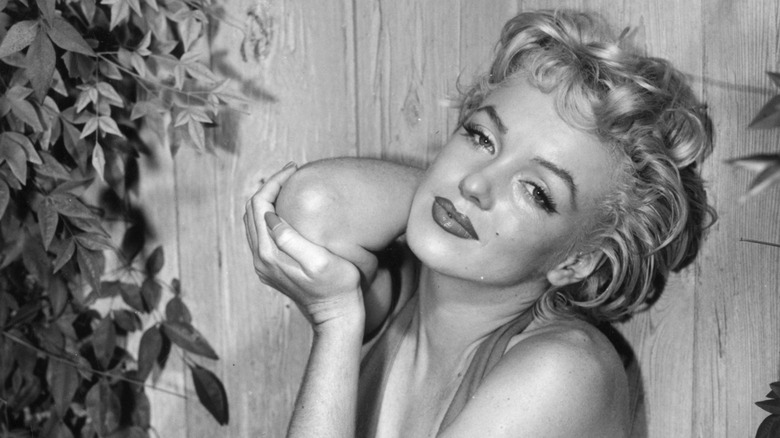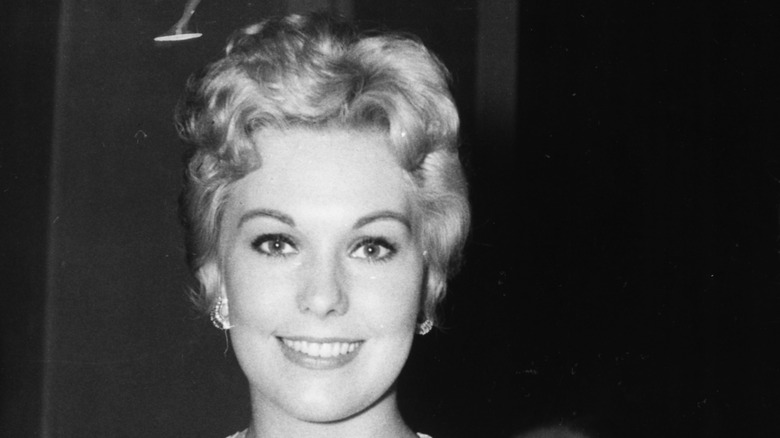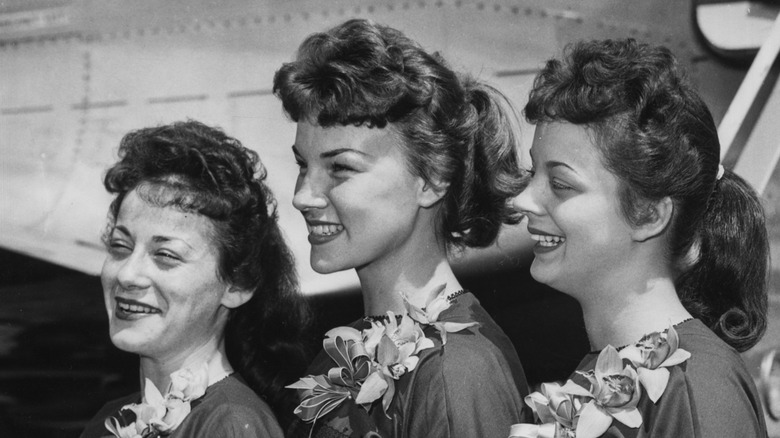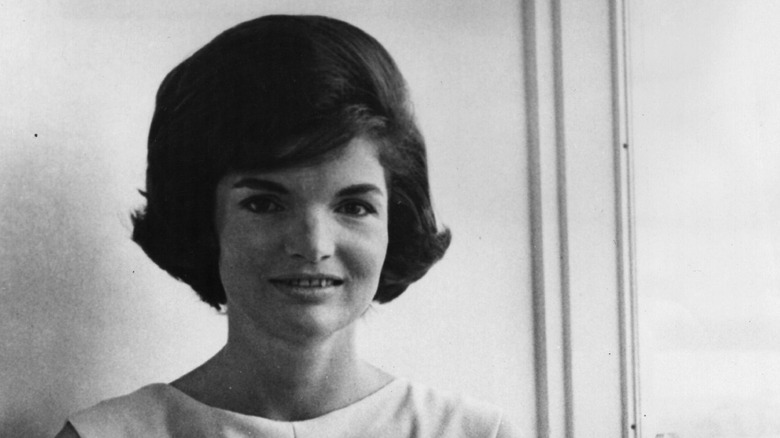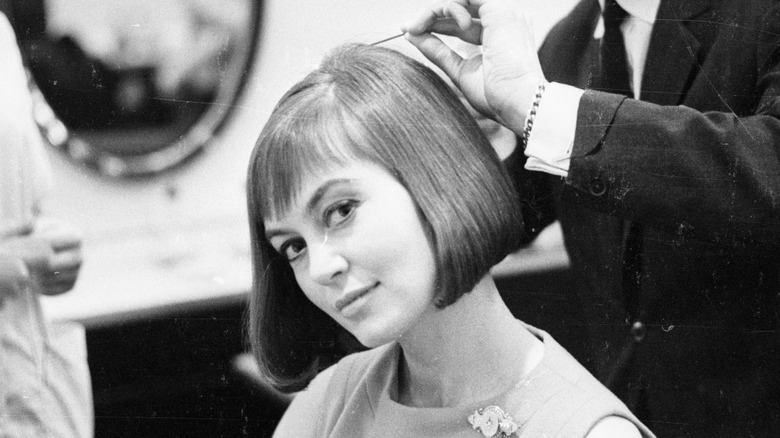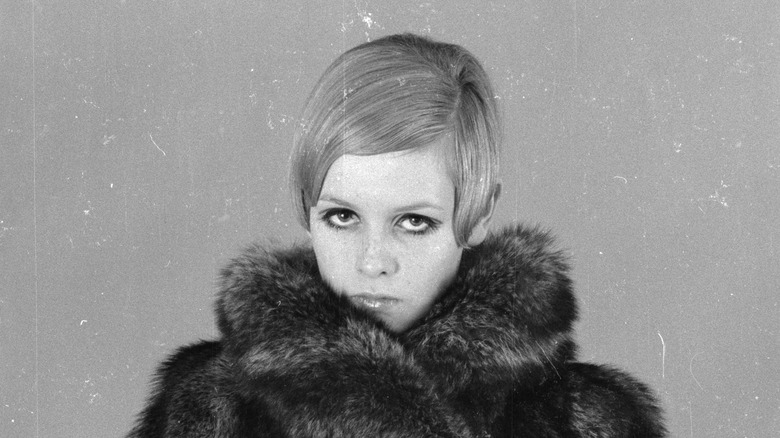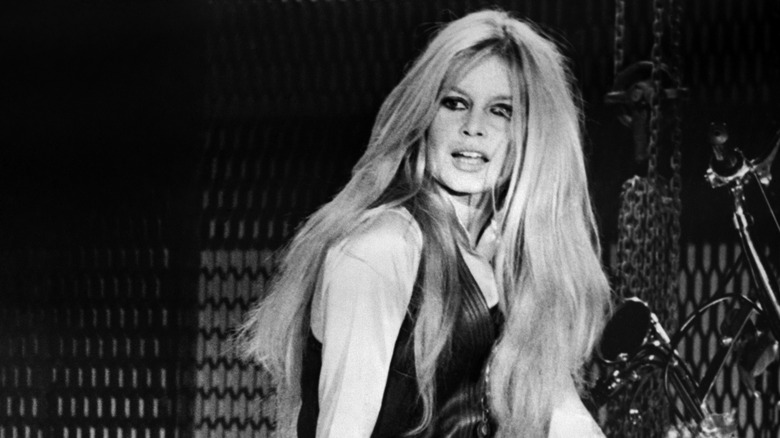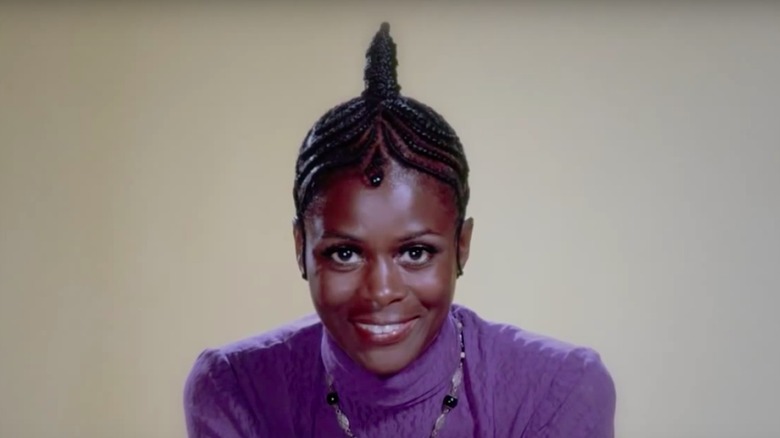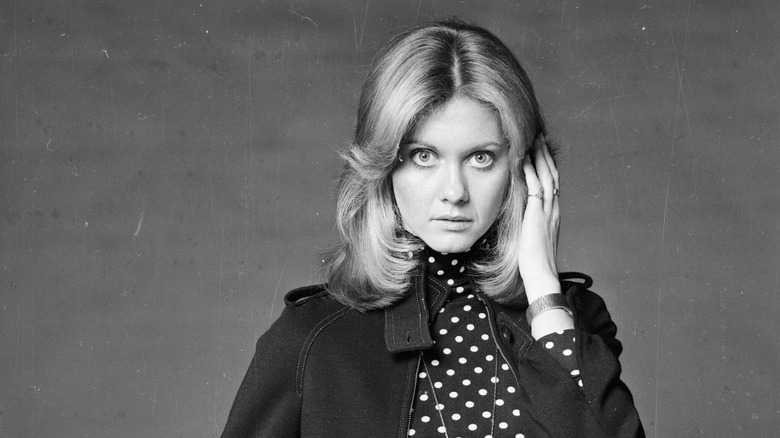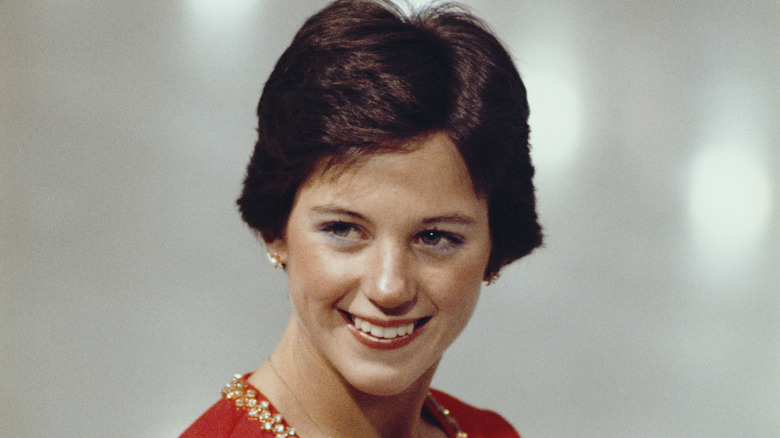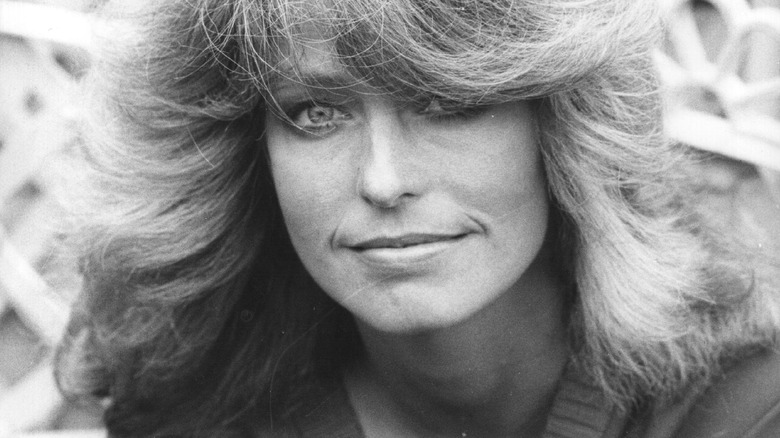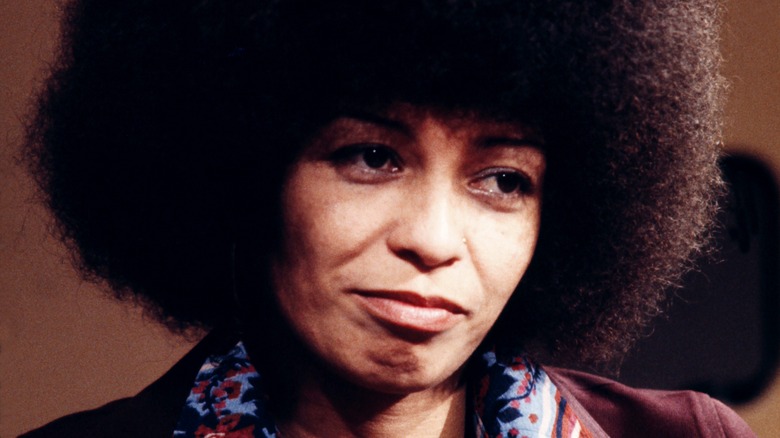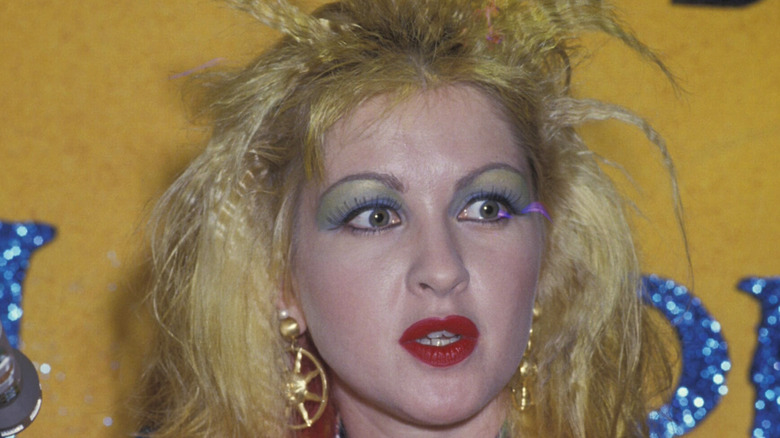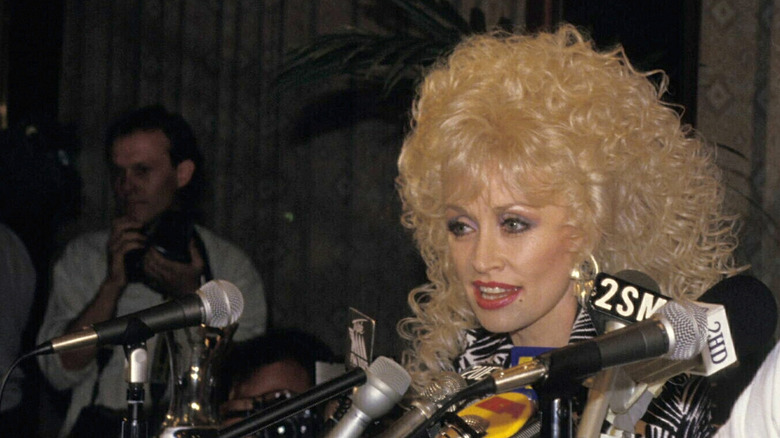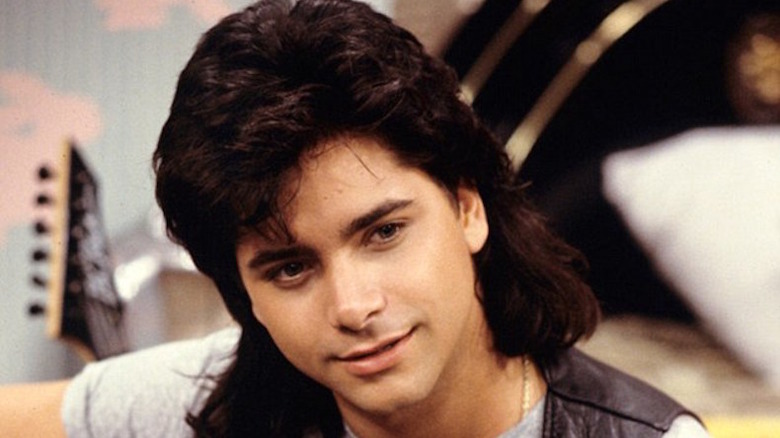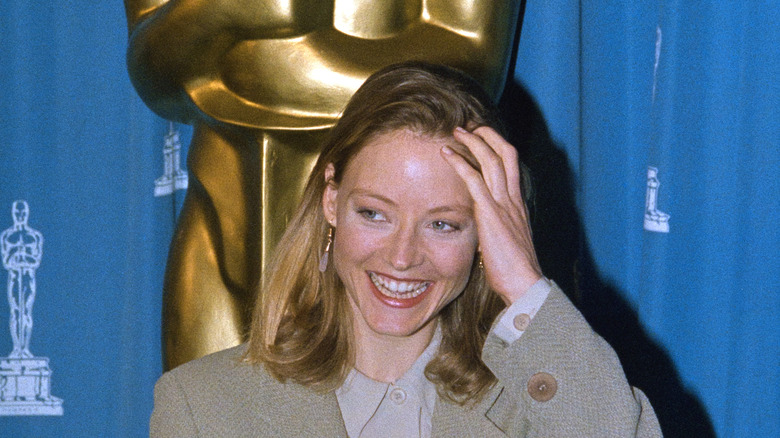The Most Popular Hairstyle The Year You Were Born
The hairstyle can make the look. Seriously, what's more important than your hair? Okay, so maybe a few things do actually trump taming the mane, but, still, it's a vital part of most women's lives. In fact, American women spend a cumulative average of six days per year doing their hair, according to Shape.
Let's say you started pampering your locks in 1987, you would have already spent six long months just on your hair by 2018. Of course, this includes washing, drying, coloring, and styling — all of which take copious amounts of time individually. Having your hair dyed at a salon could take hours, for example. Not to mention the painstaking process of blowing out your hair — that alone has felt longer than six days.
Still, women have always taken, and probably will always take, time to make their hair magnificent. Need proof? Here's a look at some of the most popular hairstyles worn the year you were born. Try to guess which one would take you the longest to pull off.
1953-54: playful curls
The years 1953 and 1954 were the it time for playful curls. First, Ava Gardner brought the trend to Hollywood. According to her biography, Gardner was only able to secure bit parts when she first came onto the scene. However, by 1946, she was well on her way to becoming a household name.
That year she played the iconic role as Kitty Collins in The Killers. In the years that followed, Gardner built up an even greater repertoire with works like The Hucksters, Show Boat, The Snows of Kilimanjaro, and then, in 1953, she received her one and only Academy Award nomination for her role in Mogambo. Her acting may have taken precedence, but her fun hairstyle could've won an award as well.
Marilyn Monroe also played an important part in popularizing the loosely-curled hairdo. Born Norma Jeane Mortenson, she decided to take up the name "Marilyn Monroe" upon starting her Hollywood career. She dyed her hair blonde and, within a few years, saw the kind of success most people can only dream of.
She signed her first movie contract in 1946, then in 1953 Monroe starred in Niagara. That same year, she went on to play Lorelei Lee in the instant hit, Gentlemen Prefer Blondes. Another comedy, How to Marry a Millionaire, came next, followed by There's No Business like Show Business in 1954. All the while, those platinum playful curls were one of her most recognizable features.
1955-58: shorter locks
Through 1958, shorter hairstyles like that of Gardner and Monroe remained popular. However, not everyone opted for the playful variety of curls. Beginning in the early 1950s, DIY permanent waving kits were available for purchase. According to the book Women's Hats, Headdresses and Hairstyles by Georgine de Courtais, women who were either too busy to make time for the salon or unable to afford to see the hairdresser could now get their curls, in a variety of styles, at home. Still, many chose Monroe-esque dos.
By the middle of the 1950s, women who were able to take advantage of professional hair services could try new processes to achieve looser curls. Courtais wrote that "cold waving and tepid waving methods, and improved skill in cutting enabled women to have casual, natural-looking hair styles."
Near the end of the 1950s, longer hair became more desirable and women started to gradually grow out their hair. During that time, you could often see women with pinned back, lightly curled locks.
1959: the high ponytail
With their hair now longer, women were free to try out some new and interesting styles, one of which being the high ponytail. In 1959, Mattel released their first Barbie doll featuring that very look. It should be noted, though, that the high ponytails of 1959 look quite a bit different than the high ponytails of today.
This "signature look" of the late '50s, as dubbed by Victoria Sherrow, author of the Encyclopedia of Hair: A Cultural History, would often feature a headscarf. As the '59 Barbie doll also shows, curled bangs were involved — eek!
The hairstyle was so popular there was even a girl group who called themselves the Poni Tails. In 1958, the singing trio ranked eighth place in the "Most Promising Singing Group" category by the The Billboard Eleventh Annual Disk Jockey Poll. Nevertheless, the band only lasted about as long as the hairstyle they were named after, fizzling out of the mainstream with their last hit, "Who When and Why," in 1960.
1960-64: the bouffant and the beehive
Although the iconic bouffant style was technically introduced as early as 1956, Women's Hats, Headdresses and Hairstyles explained it didn't really take off until four years later. In 1960, John F. Kennedy was elected president and his wife, Jacqueline "Jackie" Kennedy, became the first lady. More than that, though, she became a style icon. The bouffant just so happened to be her trademark hairstyle of the early '60s. Then, in September of 1961, Jackie Kennedy graced the cover of Life magazine, which drew even more attention to the amazing bouffant.
Along with the bouffant came a similar, yet exaggerated, style called the beehive. Aptly named, its shape is indeed reminiscent of a hive. Jackie Kennedy also donned the style created by Margaret Vinci Heldt in the early '60s. Though, she wasn't the only one.
According to pictures published by The Huffington Post, Aretha Franklin, Barbra Streisand, and Dusty Springfield also proudly rocked the coned coif. And in Breakfast at Tiffany's, Audrey Hepburn took the beehive hairstyle to a whole new level. In a poll published in 2013, people rated her hair as the most memorable hairdo of all time — out of 50 styles. The poll's creator, Sacha Mascolo-Tarbuck, told Express, "The fact the style is still topping these lists half a century since the film was released shows how iconic it really is." You can say that again!
1963-65: all about the bobs
Although the beehive was incredibly popular in the early to mid '60s, another hairstyle arrived as its rival in 1963. Vidal Sassoon completely changed the way women wore their hair. Unlike the stiff styles of bouffants, beehives, and curls, he came up with lower maintenance look termed the "wash-and-wear" look. Woot woot, Sassoon!
According to the New York Times, he was all about the cut as opposed to curlers and heavy styling. His famous cuts featured "geometric shapes and sharp angles" designed to accentuate cheekbones and otherwise complement women's facial features.
Sassoon had his big break in 1963 when he cut actress Nancy Kwan's long, flowing hair into a sharp, angular bob. Rightfully, this look became known as the Kwan bob, Kwan cut, or even just the Kwan. Before long, British and American Vogue were featuring the look he created and, of course, other women wanted similar hair (because how could you not?) and followed suit.
1966: the Twiggy pixie
In 1966, a young woman and aspiring model by the name of Lesley Hornby transformed into "Twiggy." The most important part of her transformation may have very well been her hair. According to The Telegraph, Twiggy's agent made a hair appointment for the soon-to-be star with Leonard at his eponymous salon, the House of Leonard. Three years prior, Sassoon had made big waves in hairstyling and Leonard was eager to keep up with, if not surpass, him. Alas, along came Twiggy.
He decided to take a risk and practice an extremely short, boyish cropped cut. In return, he promised to pay for Twiggy's next modeling shoot. Over eight long hours, Twiggy's hair was both dyed blonde and cut short. Her career, however, was lengthened.
Although 1996 was the year that propelled the hairstyle into popularity, it has never really gone away. Stars like Michelle Williams and Emma Watson have carried on the iconic look in modern day.
1967-72: the more-is-more philosophy
Pixie cuts may have taken off in 1966, but big hair didn't care. According to Vogue, Catherine Deneuve personified the "more-is-more philosophy" when it came to how she wore her hair. In 1967, she starred as a housewife/call girl in Belle de Jour. Her hair could be seen pulled back and up in a "glamorous mess."
InStyle also shared photos of Brigitte Bardot pulling off both the Twiggy pixie in 1956 — by way of a platinum blonde wig while performing in Mam'zelle Pigalle — and her naturally long but artificially blonde locks in 1970.
By 1972, Cher, too, was rocking all sorts of big hair. At that point in time, Cher's hair was waist-length — while in a ponytail! According to Good Housekeeping, she wore her hair teased into gigantic curls at one of her concerts that same year. Her music may have earned her the title "Goddess of Pop" but that hair certainly had to contribute, right?
1973: cornrows
Although cornrows weren't exactly an invention of the '70s, they did become popular in 1973. "History tells us cornrows originated in Africa," Toni Love, a cosmetologist and barber in Atlanta, Georgia, explained to Ebony. "Cornrows on women date back to at least 3000 B.C. and as far back as the nineteenth century for men, particularly in Ethiopia. Warriors and kings were identified by their braided hairstyles," she added.
Although many may think Bo Derek inspired the trend, as Ebony noted, she didn't actually wear the braids until 1979. Actress Cicely Tyson was the woman who brought cornrows into conventional use in '73 with her character in the film Sounder. "Every time I changed the hairdo it had not to do with me, it had to do with authenticating the character that I was playing," she explained her hairstyle on Oprah's Master Class.
Cornrows didn't stay in the 1970s, however. You can still spot celebrities — from Alicia Keys to Kim Kardashian — donning the braids today.
1974-75: down the middle and to the shoulders
In the mid-1970s, a middle of the road hairstyle emerged, which was great for those who didn't want to commit to big hair or a cropped cut. This style involved a center part and was cut just to the shoulders. When you think of '70s hair, this style is perhaps the one you think of first.
Olivia Newton-John had the iconic do in 1974 when she was busy belting out "I Honestly Love You." Suzanne Sommers also chose the style in the same year. If you were born in 1974, there's a good chance your mom also had this haircut. And, why not? It was easy enough to maintain and still a bit free-spirited without having to maintain extraordinarily long hair.
Center parts continue to be worn by celebrities, according to Elle. Kim Kardashian, Jennifer Aniston, Cameron Diaz, and many more can pull off this look. However, you generally won't see the bounce that accompanied the 1970s blowouts — surely, we're all okay with that.
1976: the epic bowl cut
You may know Dorothy Hamill as the world-famous Olympic figure skater or, possibly, as the woman who reinvented the bowl cut. Okay, technically her hair style was called a "wedge" cut but, they are mighty similar. According to Thought Co., after Hamill won the gold in 1976, her hairstyle took off and many — including little girls — emulated the athlete's hair. Hamill went on to endorse White Rain hair products, which only helped the hairstyle increase in popularity.
In Hamill's memoir, A Skating Life: My Story, she explains how she hated having short, hair but it was easiest to maintain. After reading about famous hairstylist Suga in magazines, she got to thinking. "My dad had written him a letter asking him if he could cut my hair for the Olympics," she wrote. How adorable is that? Suga ultimately said yes and the rest is, as you well know, history. "Of course, I had no idea that this wedge style would become so famous. I just thought if I had to have short hair anyway, I might as well have something fashionable," wrote Hamill. You definitely can't fault that logic.
Although the wedge is no longer popular, Hamill's hairstyle lives on at the HAIRevolution Exhibition in Denver, Colorado as of 2002, Thought Co. reported.
1977-78: Farrah Fawcett's feathered locks
You can't think of Farrah Fawcett without also thinking of her incredible feathered mane. In 1976, Fawcett was cast to play one of the leads on Charlie's Angels. One year later, her hairstyle — "the Farrah" — became all the rage. According to InStyle, it brought in a ton of business to her hairstylist, Allen Edwards. "People were lining up down the street," he later said.
Fawcett even went on to work with Faberge, a popular cosmetics company from the late 1970s to the mid-1980s. They formulated their very own Farrah Fawcett Shampoo — yes, she had her own shampoo line (plus hair spray, creme rinse, and conditioner, according to People).
People also reported that Fawcett liked to be involved in her products. While touring the New Jersey Faberge plant, Fawcett even gave workers suggestions, including, "I like my hair squeaky but not too squeaky — maybe we should add some vinegar." No word on what Faberge decided to do with her advice, but Fawcett enjoyed feeling a part of the team regardless.
1975-79: the natural hair movement
The Civil Rights Movement spawned another great movement: the natural hair movement, according to History. Black men and women began accepting their au naturel hair and stopped using destructive hair products. Donning natural dos was a silent show of activism and, as History explained, symbolized reclaiming their roots — by quite literally reclaiming their roots.
Afros were one such way. Of course, these hairstyles weren't without criticism. Many thought natural hair looked "unprofessional." Nevertheless, icons, like the great Angela Davis, persisted in popularizing the look, giving the confidence others needed to continue.
Although the height of the afro style was in the mid- to late-70s, it never truly went away. Dee Carrington, a hairstylist in Florida, explained to Ebony, "I'd venture to say the Afro is the cornerstone of the movement, but it has emerged as something more unique as it relates to each individual. Now we have so many different Afro shapes and sizes."
1980-84: such a tease
Farrah Fawcett may be best known for her feathered hair but that doesn't mean she didn't change with the times. By 1980, a new trend emerged: teased hair. This style may be the most memorable of the '80s because anyone who was anyone did their this way.
According to InStyle, Fawcett dove headfirst into the trend by 1984, when she was starring in The Red-Light String, a CBS miniseries. Of course, Fawcett was but one celebrity who tried the tease. Cyndi Lauper added some punk flare to her teased tussles while Madonna was all about the big bangs.
You may cringe when seeing the hairstyle now, but it could actually be trickling back. In 2015, Good Housekeeping reported seeing "seriously voluminous" hair on runway models and, by 2016, StyleCaster declared back-combing (ahem, teasing) back in style. Of course, teased hair circa 2018 looks much different than its 1980s predecessor.
1985-89: curls and perms
From the middle of the '80s through to the end of the decade, curls took center stage. Celebrities from Whitney Houston to Dolly Parton took part in the trend. And what a trend it was. If you didn't have naturally curly hair, the permanent weave (or "perm" as it was, and is, widely known) quickly became your best friend.
According to Complex, perms meant "dousing your hair with chemicals" and then heating your hair under dryers to activate. The chemicals also produced a nasty, strong odor as many of you may remember. Self explained that the smell was caused by thioglycolic acid (thio). Additionally, the iconic tight curls that have become so synonymous with the '80s are because of the small and thin rods used during the perming process. The '80s were certainly a different time.
These days, you can still get a perm. However, you'll likely want to opt for large rods for loose waves and a thio-free variety to avoid that horrible smell. Bad news, though, perm-lovers: they're still pretty damaging to your hair, according to Self.
1987-89: that mullet, though
In the midst of the curl and perm trend, another hairstyle was picking up steam: the mullet. According to the book Fabulous Fashions of the 1980s by Felicia Lowenstein Niven, mullets involves cutting the top of the hair and sides in short layers while the back is left long.
"Sometimes the change in length is smoothly blended. Other times, you can really see the two levels," Niven explained. Yes, the mullet looked as bad as it sounds. What makes this haircut even more phenomenal — or phenomenally awful — is that it was unisex. That's right, men and women both took part in this trend.
Perhaps the most popular mullet of the decade was John Stamos' in 1987. He had just started starring as Uncle Jesse in Full House and, fortunately or unfortunately, the hair came with him. He said in retrospect during the 2015 Television Critics Association Press Tour (via E! News), "It was like two crows had died on my head!" He added, "I look now and I go, 'Why didn't anybody say something to me?!'" Based on how popular the mullet was at that time, surely no one knew just how bad it was.
1990-93: keeping it simple
Welcome to 1990: when big, bold hair was out and the minimalist mane was in. Kate Moss' '90s hair showed just how perfect unfussy hair could be. From tousled wet waves to a simple pulled back ponytail, Moss rocked the on-trend do.
Celebrities like Jodie Foster and Alicia Silverstone also joined in, each sporting the hairstyle in their own way. While Foster often kept her hair down, Silverstone wore her hair pin-straight and long — sometimes with a headband, small clips, or even the dreaded claw clip. Ah, the claw. While you likely still have one of those handy-dandy clips to throw your hair in after your shower or to keep your hair dry while taking a bath, people did actually wear those out in public.
Women also wore something called "scrunchie barrettes." Essentially, you'd pull your long hair back into a high ponytail and "decorate" the top of your head with the part-scrunchie, part-clip invention. The '90s may have been a time of simple hair but it was not always an era of uncomplicated hair accessories. What a time to be alive!
